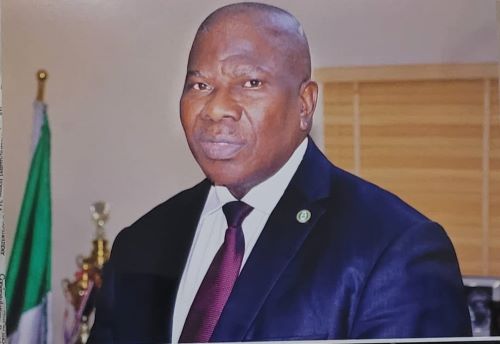Mr. O. S. Thomas
Commissioner for Insurance/CEO
National Insurance Commission (NAICOM)
Despite challenges of the post-COVID-19 era, the Nigerian insurance sector has continued to compete fairly with its peers in Africa in terms of Gross Premium Income (GPI), expanding market size, retention capacity and keeping faith with policyholders in claims settlement.
In Nigeria, the sector remains one of the most resilient and fastest growing segments of the national economy, contributing sustainably to Gross Domestic Product (GDP) and job creation.
An industry performance report (2017-2022) by the National Insurance Commission (NAICOM) shows a growth rate of 65.6 percent to the tune of N372.4 billion in 2017 to N616.6 billion in 2021.
Presented by Dr. Umaru Baba, Head of Statistics at NAICOM, the Commission stated:
“During the period, the rate of growth was put at 14.2 percent for 2017, 14.5 percent in 2018 and 19.2 percent, 1.2 percent and 19.7 percent for 2019. 2020 and 2021 respectively. Interestingly, the market recorded expansion in 2020 during the pandemic when the real GDP actually contracted (-1.9%) as was the case with most economies around the world. In 2021 for instance, while the annual rate of premium growth in Nigeria stood at 19.7 percent, it was 12 percent in Tanzania, 18.5 percent for Egypt and about 7.6 percent in the emerging insurance market of Malaysia. It is apparent that the trend maintained a steady rise except in 2020 of which it took a v-shaped recovery thereafter, rebounded to about 20 percent in 2021.”
The report stated that “in 2022, the GPI stood at N223.8 billion in the first quarter, which was 6 percent growth on YoY and, N369.2 billion in the second quarter, indicating a 65 percent Quarter-on-Quarter (QoQ) growth and at about 20 percent Year-on-Year (YoY). Apparently outpacing the real economic growth which grew at just about 3.5 percent during same period, major drivers during the period of 2017 – 2021 were the special risk insurance of Marine & Aviation at about 170 (169.6 percent) per cent, Miscellaneous Insurance at 98.4 percent and Life Insurances at 71.3 percent. In 2022 however, Fire Insurance (32.5 percent) and Life business (24.5 percent) recorded highest rates at the end of H1 period, YoY.”
And in terms of retention capacity, the Nigerian market has proved to be resilient, not only with regards to premium generation but the capacity to retain businesses which signifies sound financial stability and carriage capacity.
In tandem with the GPI growth, it recorded a positive trajectory in business retention from N265.5 billion to N441.2 billion (66.2 percent) over the period of 2017 to 2021, with the retention growth highest in Marine & Aviation, growing at 169.7 percent over the period while General Accident Insurance retention lagged at about 24.6 percent over the same period.
This clearly signifies the growing retention capacity by Nigerian insurers as the aggregate five-year retention ratio of the industry stood at 72.1 percent as the portfolios of Motor (93.1 percent) and Life business (91.8 percent) led the market.
Even in 2020, the industry recorded a retention ratio of about 71.6 percent, higher than the advanced climes of Australia (69.4 percent) and Turkey (70.9 percent) and indeed the developing market of Egypt (58.1 percent) among others
In 2022, retention experience in the first half in Life business retention was 93 percent while non-life recorded a ratio of 55 percent as the industry average stood at about 71 (70.5) percent. All Non-Life classes stood at an above average position except for the Oil & Gas (40.1 percent) even as it declined further compared to its retention capacity in the corresponding period (42.3 percent) of 2021
“Gross claims reported a fluctuation over the period to peak at a growth proportion of 36.2 percent over the years representing N336.8 billion in 2021 from N186.4 billion in 2017, owing to improved market discipline and the approach of customer focused regulation, remained very high around the border of 70 percent. In 2019 however. while the gross claims reported declined by about 11 percent, the ratio of net claims paid stood at 69.3 percent. In all other years except 2017 (67 percent), it was at least around the border of 70 percent with the highest recorded at about 84 percent in the H1 period of 2022.”
The report also states that in the pandemic year of 2020, despite macro-economic challenges, about 70 percent of all reported claims were settled by insurers within the specified period, just as the industry also remained profitable with loss ratios within the average range numbers, with highest in 2018 at 59.2 percent.
On industry size, the report states: “Sustained Assets growth of the industry even during economic recessions, highest in 2020 (34.6 percent) indicates the immense investment flow and, due to recapitalisation measures taken during that period the industry total assets almost doubled over the five- year period of 2017 to 2021, depicting a positive interest of investors in the market at a time associated with macro-economic volatilities. In 2022, the market recorded an expansion to about N2.3 trillion at the end of H1, growing at 12.0 percent YoY. From the on-going, the insurance sector should be the future redeemer of the Nigerian economy given its growth rate, pattern, resilience and yet untapped potential.”
The challenge of future growth of the sector depends largely on deepening market penetration strategies such as compulsory insurances, digitalisation and micro schemes to tap into the huge rural potential.
